Accepted Scientific Name: Polaskia chichipe (Rol.-Goss.) Backeb.
Cact. Succ. J. (Los Angeles) xxiii. 121 (1951)
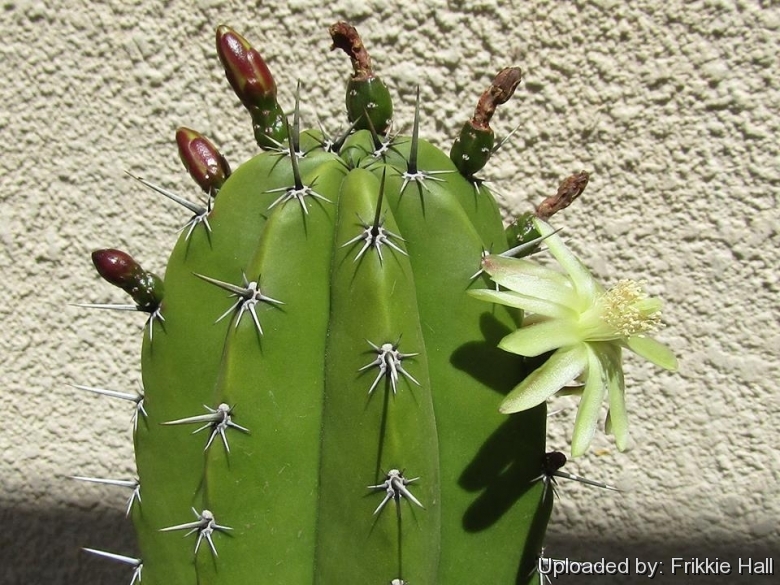
Lemaireocereus mixtecensis (Polaskia chichipe) Photo by: Frikkie Hall
Origin and Habitat: Polaskia chichipeSN|7736]]SN|7736]] is endemic to the warmer areas of central Mexico (Tehuacán-Cuicatlán Valley and adjacent Mixteca Alta in the Mexican States of Oaxaca and Puebla)
Altitude: It grows at elevations of 1,600 to 2,300 metres above sea level.
Habitat and Ecology: Polaskia chichipeSN|7736]]SN|7736]] occurs in the wild on alluvial limestone fans and shallow black soil in xerophyllous thorn-scrub forests together with Neobuxbaumia mezcalaensisSN|6390]]SN|6390]], Heliabravoa chendeSN|7732]]SN|7732]], Mammillaria conspicuaSN|20872]]SN|20872]], Ferocactus robustusSN|21488]]SN|21488]], Agave karwinskiiSN|23013]]SN|510]], Agave lechuguillaSN|510]]SN|23013]] and Yucca periculosaSN|29988]]SN|29988]]. It is abundant, tolerated and even promoted in agricultural lands, has no threats, and occurs within protected areas.
Synonyms:
See all synonyms of Polaskia chichipe
Common Names include:
SPANISH (Español): Chichipe, Chichibe, Chichituna, Chichitun
Description: Polaskia chichipeSN|7736]]SN|7736]] is a columnar tree-like cactus with many curved branches, up to 5 m tall. Usually with short trunk and branching freely at the top. This species has small diurnal yellowish green flowers that extend their anthesis into the following the night. Polaskia chichipeSN|7736]]SN|7736]] is cultivated for its edible fruits in Mexico.
Stems: Cloumnar, greenish powdery-grey.
Robs: 9 to 12, wavy and acute often with reddish coloration of the edges in winter.
Areoles: 1 to 1.5 cm apart.
Spines: Greyish up to 5 cm but usually shorter; 6-7(-8) radials and 1 longer central spine. Spines stout and fade as it the plant ages.
Flowers: Flowers are smal, open cups of pinkish white or yellow-green. The anthesis is diurnal as well as partly nocturnal.
Fruit: 2-3 cm edible.
Phenology: The species flowers in habitat between March and June, and produces fruits between June and August.
Subspecies, varieties, forms and cultivars of plants belonging to the Polaskia chichipe group
 Polaskia chichipe (Rol.-Goss.) Backeb.: It is a columnar tree-like cactus with many curved branches, up to 5 m tall.
Polaskia chichipe (Rol.-Goss.) Backeb.: It is a columnar tree-like cactus with many curved branches, up to 5 m tall. Polaskia chichipe f. cristata hort.: Crested form with sculptural shape and powdery grey-blue epidermis. Older crested plant can reach a considerable size (up to 2 m tall and in diameter, or more )
Polaskia chichipe f. cristata hort.: Crested form with sculptural shape and powdery grey-blue epidermis. Older crested plant can reach a considerable size (up to 2 m tall and in diameter, or more )
Notes: The genus Polaskia comprise 2 species: Polaskia chichipeSN|7736]]SN|7736]] which is related to to Myrtillocactus and Polaskia chende which is nearer to Stenocereus.
Bibliography: Major references and further lectures
1) Edward Anderson “The Cactus family” Timber Press, Incorporated, 2001
2) James Cullen, Sabina G. Knees, H. Suzanne Cubey "The European Garden Flora Flowering Plants: A Manual for the Identification of Plants Cultivated in Europe, Both Out-of-Doors and Under Glass" Cambridge University Press, 11/Aug/2011
3) David R Hunt; Nigel P Taylor; Graham Charles; International Cactaceae Systematics Group. "The New Cactus Lexicon" dh books, 2006
4) Urs Eggli, Leonard E. Newton: “Etymological Dictionary of Succulent Plant Names” Springer, Berlin/Heidelberg 2010
5) Christopher Brickell “RHS Encyclopedia of Plants and Flowers” Dorling Kindersley Ltd, 01/Sep/2010
6) Willy Cullmann, Erich Götz (Dozent Dr.), Gerhard Gröner “The encyclopedia of cacti” Timber Press, 1987
7) Gerhard Gröner, Erich Götz “Beautiful Cacti: A Basic Grower's Guide” Sterling, 1992
8) Hecht “BLV Handbuch der Kakteen” BLV-Verlagsgesellschaft, 1982
9) E Haustein “Der Kosmos Kakteenfuehrer (the Kosmos Cactus Guide)” Balogh Scientific Books, United States, 01/Dec/1998
10) Arias, S. & Zavala-Hurtado, A. 2013. Polaskia chichipe. In: IUCN 2013. "IUCN Red List of Threatened Species." Version 2013.2. <www.iucnredlist.org>. Downloaded on 25 April 2014.
11) Jules Janick, Robert E. Paull "The Encyclopedia of Fruit & Nuts" CABI, 2008
12) Clive Innes "Complete Handbook of Cacti and Succulents" Van Nostrand Reinhold Company, 01/dic/1981
13) Adriana Otero-Arnaiz et alt.“Genetic variation and evolution of Polaskia chichipe (Cactaceae) under domestication in the Tehuacán Valley, central Mexico” Molecular Ecology Volume 14, Issue 6 May 2005
14) Flora 205 (2010) 757–763
15) Helmut E. Walter “Floral biology of Echinopsis chiloensis ssp.chiloensis (Cactaceae): Evidence for a mixed pollination syndrome” Flora 205 (2010) 757–763
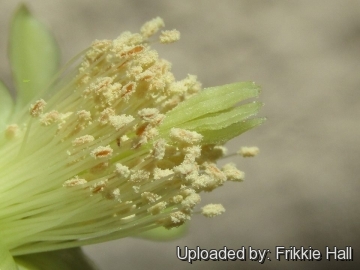 Lemaireocereus mixtecensis (Polaskia chichipe) Photo by: Frikkie Hall
Lemaireocereus mixtecensis (Polaskia chichipe) Photo by: Frikkie Hall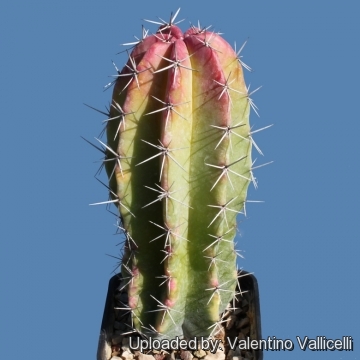 Lemaireocereus mixtecensis (Polaskia chichipe) Photo by: Valentino Vallicelli
Lemaireocereus mixtecensis (Polaskia chichipe) Photo by: Valentino Vallicelli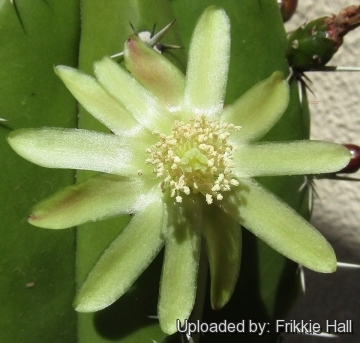 Lemaireocereus mixtecensis (Polaskia chichipe) Photo by: Frikkie Hall
Lemaireocereus mixtecensis (Polaskia chichipe) Photo by: Frikkie Hall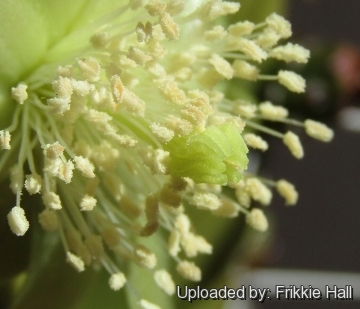 Lemaireocereus mixtecensis (Polaskia chichipe) Photo by: Frikkie Hall
Lemaireocereus mixtecensis (Polaskia chichipe) Photo by: Frikkie Hall Lemaireocereus mixtecensis (Polaskia chichipe) Photo by: Frikkie Hall
Lemaireocereus mixtecensis (Polaskia chichipe) Photo by: Frikkie HallSend a photo of this plant.The gallery now contains thousands of pictures, however it is possible to do even more. We are, of course, seeking photos of species not yet shown in the gallery but not only that, we are also looking for better pictures than those already present.
Read More... Cultivation and Propagation: Polaskia chichipeSN|7736]]SN|7736]] grow slowly and are cold intolerant, make sure that they are not exposed to freezing temperatures or they may die. During the summer it is best to keep the plants outside where the temperature can rise to over 30 C with no harm to the plant. Furnish good drainage and use a an open and free draining mineral compost that allows therefore roots to breath. They like only a short winter's rest and should be kept almost completely dry during the winter months, If the soil is allowed to be dry for too long root loss could follow but equally the same result would occur if the plants are both wet and cold. From March onwards the plant will begin to grow and watering should be increased gradually until late May when the plant should be in full growth.
Water regularly during the summer so long as the plant pot is allowed to drain and not sit in a tray of water. During hot weather you may need to water the plants more frequently so long as the plant is actively growing. From late September watering should be reduced to force the plant to go in to a state of semi dormancy, by October you should be back in to the winter watering regime.
Need full sun avoiding only the harshest summer sun, if kept too dark they may become overly lush and greener and could be prone to rotting due to over watering.
Feeding may not be necessary at all if the compost is fresh then, feed in summer only if the plant hasn't been repotted recently. Do not feed the plants from September onwards as this can cause lush growth which can be fatal during the darker cold months.
Propagation: By vegetative propagation (stem cuttings) or (usually) by seeds.
Economical uses: Polaskia chichipeSN|7736]]SN|7736]] is cultivated in central Mexico for its edible red fruits (chichituna) and branches used as fuel wood. Cultivated plants have larger and sweeter fruits, a longer period of fruit production, and are self-compatible. Polaskia chichipeSN|7736]]SN|7736]] is under artificial selection in central Mexico because of its edible fruits.















